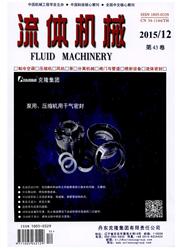

 中文摘要:
中文摘要:
应用计算流体动力学方法(CFD)对往复式压缩机进气阀的工作过程进行内流场的瞬态数值模拟,确定了膨胀、进气过程中温度场、压力场、速度场等物理场的分布,研究了曲轴转速、弹簧刚度对进气阀工作特性的影响。计算结果表明:进气阀工作过程的仿真必须对膨胀和进气过程进行连续动态模拟以确定工作特性;对于一定结构的进气阀,当弹簧刚度由455N/m增大到8000N/m时,压缩机进气量从11.3×10^-3m^3降至8.8×10^-3m^3,因为泄漏,在刚度为2000N/m时具有最大实际入量11.2×10^-3m^3;当曲轴转速由300r/min提高到2000r/min时,实际吸入量由11.6×10^-3m^3降至8.6×10^-3m^3;从避免阀片颤振、降低瞬时流量波动、限制关闭滞后角和泄漏量以及提高实际吸入气量等方面综合考虑,较合理的弹簧刚度在2000N/m左右,大于原设计的455N/m。通过对进气阀的数值模拟,为优化弹簧刚度、进一步分析变转速下气阀的工作性能提供了依据。
 英文摘要:
英文摘要:
In order to study the influences of crank speed and spring stiffness on the performance of reciprocating compressor suction valve, the fluid-thermal-structure multi-physics coupling simulation based on Computational Fluid Dynamics method is employed to determine the temperature ,pressure,velocity fields during expansion and suction. The simulation results show that the air inflow is form 11.3×10^-3m^3to 8.8 ×10^-3m^3 when the spring stiffness raises from 455N/m to 8000N/m for a special compressor, but the maximal net import air volume in the intake process is 11.2 ×10^-3m^3 at a stiffness of 2000N/m for the leak- age. Besides, the net air inflow drops form 11.6 ×10^-3m^3 to 8.6 ×10^-3m^3 when the crankshaft speed raised from 300r/min to 2000r/min. Therefore, the performance of suction valve can be improved by adjusting the spring stiffnes and the crankshaft speed to avoid valve flutter, reduce the transient flux fluctuation, limit the delay-closing and leakage of suction valve, and increase the net air flow. The preferable spring stiffness and crankshaft speed are about 2000N/m, which is larger than the original stiffness 455N/m. Through the multi-physics coupling simulation, the valid reference is provided for optimizing spring stiffness and inves- tigating the inlet valve at variable speeds.
 同期刊论文项目
同期刊论文项目
 同项目期刊论文
同项目期刊论文
 Stabilization of networked control systems with short or long random delays: A new multirate method.
Stabilization of networked control systems with short or long random delays: A new multirate method. 期刊信息
期刊信息
